
Cyprinidae is a family of freshwater fish commonly called the carp or minnow family, including the carps, the true minnows, and their relatives the barbs and barbels, among others. Cyprinidae is the largest and most diverse fish family, and the largest vertebrate animal family overall, with about 3,000 species; only 1,270 of these remain extant, divided into about 200 valid genera. Cyprinids range from about 12 mm (0.5 in) in size to the 3 m (9.8 ft) giant barb. By genus and species count, the family makes up more than two-thirds of the ostariophysian order Cypriniformes. The family name is derived from the Greek word kyprînos.

Cypriniformes is an order of ray-finned fish, which includes many families and genera of cyprinid fish, such as barbs, gobies, loaches, botias, and minnows. Cypriniformes is an “order-within-an-order”, placed under the superorder Ostariophysi—which is also made up of cyprinid, ostariophysin fishes. The order contains 11-12 families, over 400 genera, and more than 4,250 named species; new species are regularly described, and new genera are recognized frequently. Cyprinids are most diverse in South and Southeast Asia, but are entirely absent from Australia and South America. At 112 years old, the longest-lived cypriniform fish documented is the bigmouth buffalo.

Rhodeus is a genus of cyprinid fish, consisting of 23 species called bitterlings. The scientific name is derived from the Greek word rhodeos, meaning "rose". Most species in the genus are restricted to Asia, but two species are found in Europe.

Tanakia is a genus of cyprinid fish, consisting of seven species that occur in Eastern Asia. The type species is the Tanakia limbata.

The European bitterling is a temperate freshwater fish belonging to the subfamily Acheilognathinae of the family Cyprinidae. It originates in Europe, ranging from the Rhone River basin in France to the Neva River in Russia. It was originally described as Cyprinus amarus by Marcus Elieser Bloch in 1782, and has been referred to in scientific literature as Rhodeus sericeus amarus. It is known simply as "the bitterling" in its native range, where it is the only species of its genus Rhodeus, and sometimes in the scientific literature, also, but this is technically wrong, being a leftover from the times when the European bitterling was united with its Siberian relative, the Amur bitterling, in R. sericeus. Properly, "bitterling" can refer to any species of Acheilognathus or Rhodeus.

Rhodeus smithii, sometimes known as the Japanese rosy bitterling, Japanese bitterling, or Nippon baratanago is a temperate freshwater fish belonging to the Acheilognathinae subfamily of the family Cyprinidae. It originates in stagnant waters in inland rivers in Japan. It was originally described as Achilognathus smithii by Charles Tate Regan in 1908, and is also referred to as Rhodeus ocellatus smithii in scientific literature.

Acheilognathus is a genus of cyprinid fish native to Asia. The name is derived from the Greek a, meaning "without", the Greek cheilos, meaning "lip", and the Greek gnathos, meaning "jaw".

The Deepbody bitterling or Itasenpara bitterling is a species of freshwater fish in the family of Cyprinidae. It is endemic to central and southern Japan. It grows to a maximum length of 8.0 cm.

Labeoninae is a doubtfully distinct subfamily of ray-finned fishes in the family Cyprinidae of order Cypriniformes. They inhabit fresh water and the largest species richness is in the region around southern China, but there are also species elsewhere in Asia, and some members of Garra and Labeo are from Africa. They are a generally very apomorphic group, perhaps the most "advanced" of the Cyprinidae. A common name for these fishes is labeonins or labeoins.

The striped bitterling is a species of freshwater ray-finned fish in the genus Acheilognathus. It is endemic to Lake Biwa and Lake Yogo in Japan. It typically grows to a length of 6.0 cm.
Acheilognathus macromandibularis is a species of freshwater ray-finned fish in the genus Acheilognathus. It is endemic to China. It grows to a maximum length of 5.2 cm (2.0 in).
Acheilognathus tonkinensis is a species of cyprinid fish in the subfamily Acheilognathinae. It is found in northern Vietnam, Laos, and southern China. It occurs in rivers and deposits its eggs inside freshwater mussels.

Acheilognathus macropterus is a species of cyprinid fish native to China and northern Vietnam. It grows to a length of 27.5 centimetres (10.8 in) SL.

The danionins are a group of small, minnow-type fish belonging to the family Cyprinidae. Species of this group are in the genera clades danio and devario, based on the latest phylo-genetic research by Fang et al in 2009. They are primarily native to the fresh waters of South and Southeast Asia, with fewer species in Africa. Many species are brightly coloured and are available as aquarium fish worldwide. Fishes of the danio clade tend to have horizontal stripes, rows of spots, or vertical bars, and often have long barbels. Species within the devario clade tend to have vertical or horizontal bars, and short, rudimentary barbels, if present at all. All danionins are egg scatterers, and breed in the rainy season in the wild. They are carnivores, living on insects and small crustaceans.

Gobioninae is a monophyletic subfamily of Eurasian cyprinid fishes. A species-rich subfamily, it is divided into five tribes: Gobionini, Pseudogobionini, Hemibarbini, Coreiini, and Sarcocheilichthyini.

The Tokyo bitterling is a temperate freshwater fish of the carp family (Cyprinidae). Taxonomically, it belongs to the subfamily Acheilognathinae.

The ginbuna, sometimes referred to as silver crucian carp or Japanese silver crucian carp, is a species of freshwater fish in the carp family. It is native to lakes and rivers in Japan.
Rhodeus albomarginatus is a species of freshwater ray-finned fish in the genus Rhodeus. It is endemic to China, where it is found in the Lvjiang River of the Yangtze River drainage and uses the freshwater mussel Ptychorhynchus murinum as its host for spawning.
Sinorhodeus microlepis is a bitterling native to the Yangtze river in Chongqing City, China, and it is the only member of the genus Sinorhodeus. This species breeds in the Asian clam, which is different from all other bitterling-like cyprinids.

Squaliobarbinae is a small subfamily of the carp and minnow family, Cyprinidae, which consists of three monotypic genera which have their natural distributions in eastern Asia. Two species, the grass carp and the black carp, have been introduced to other parts of the world for weed control and aquaculture. They are large cyprinids characterised by an enlarged subtemporal fossa, the palate articulating with the supraethmoid, an enlarged intercalar bone in the cranial vault, and a divided levator posterior muscle.
















